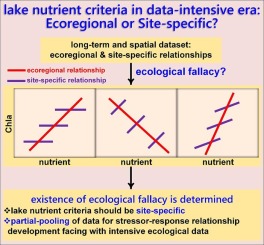Ecological Indicators ( IF 6.9 ) Pub Date : 2019-12-14 , DOI: 10.1016/j.ecolind.2019.105989 Zhongyao Liang , Feifei Dong , Song S. Qian , Yong Liu , Huili Chen , Wentao Lu

|
Ecoregional nutrient criteria are widely used but their validity has rarely been verified competed with site-specific criteria. In this study, we introduced ecological fallacy, which describes phenomenon that site-specific stressor-response relationships cannot be deducted from ecoregional relationship and vice versa, to explore the spatial scale of nutrient criteria. A long-term and nationwide water quality dataset of lakes and reservoirs was used to determine if ecological fallacy existed or not. Ecoregional and site-specific nutrient-Chlorophyll a relationships were built employing Bayesian linear model and hierarchical model, respectively. By comparing ecoregional and site-specific relationships, we found that ecological fallacy existed in each ecoregion. Ecoregional relationship may misidentify limiting nutrient or miscalculate the nutrient effect direction or magnitude. We found huge differences between estimated Chlorophyll a concentrations deduced from regional and site-specific relationships conditioning average TN or TP concentrations. Based on these results, we determined that lake nutrient criteria should be site-specific, primarily to avoid ecological fallacy rather than to improve their accuracy. These findings could guide the future nutrient criteria development. We further recommended partial pooling of data to develop stressor-response relationship facing with intensive environmental and ecological data.
中文翻译:

生态区域或特定地点的湖泊养分标准?来自生态谬误的证据
生态区域养分标准被广泛使用,但其有效性很少与特定地点的标准竞争。在这项研究中,我们引入了生态谬误,它描述了不能从生态区域关系中推断出特定地点的应激反应关系的现象,反之亦然,以探索营养标准的空间尺度。一个长期的全国性湖泊和水库水质数据集被用来确定是否存在生态谬误。生态区域和特定地点的营养素叶绿素a分别使用贝叶斯线性模型和层次模型建立关系。通过比较生态区域和特定地点的关系,我们发现每个生态区域都存在生态谬误。生态区域关系可能会错误地确定限制养分或错误地计算养分效应的方向或幅度。我们发现估计的叶绿素a之间存在巨大差异由区域和特定地点的关系推论得出的浓度,这些浓度会调节平均TN或TP浓度。根据这些结果,我们确定湖泊养分标准应针对特定地点,主要是为了避免生态谬误,而不是提高准确性。这些发现可以指导未来营养标准的制定。我们还建议对数据进行部分汇总,以建立面对密集的环境和生态数据的压力响应关系。



























 京公网安备 11010802027423号
京公网安备 11010802027423号